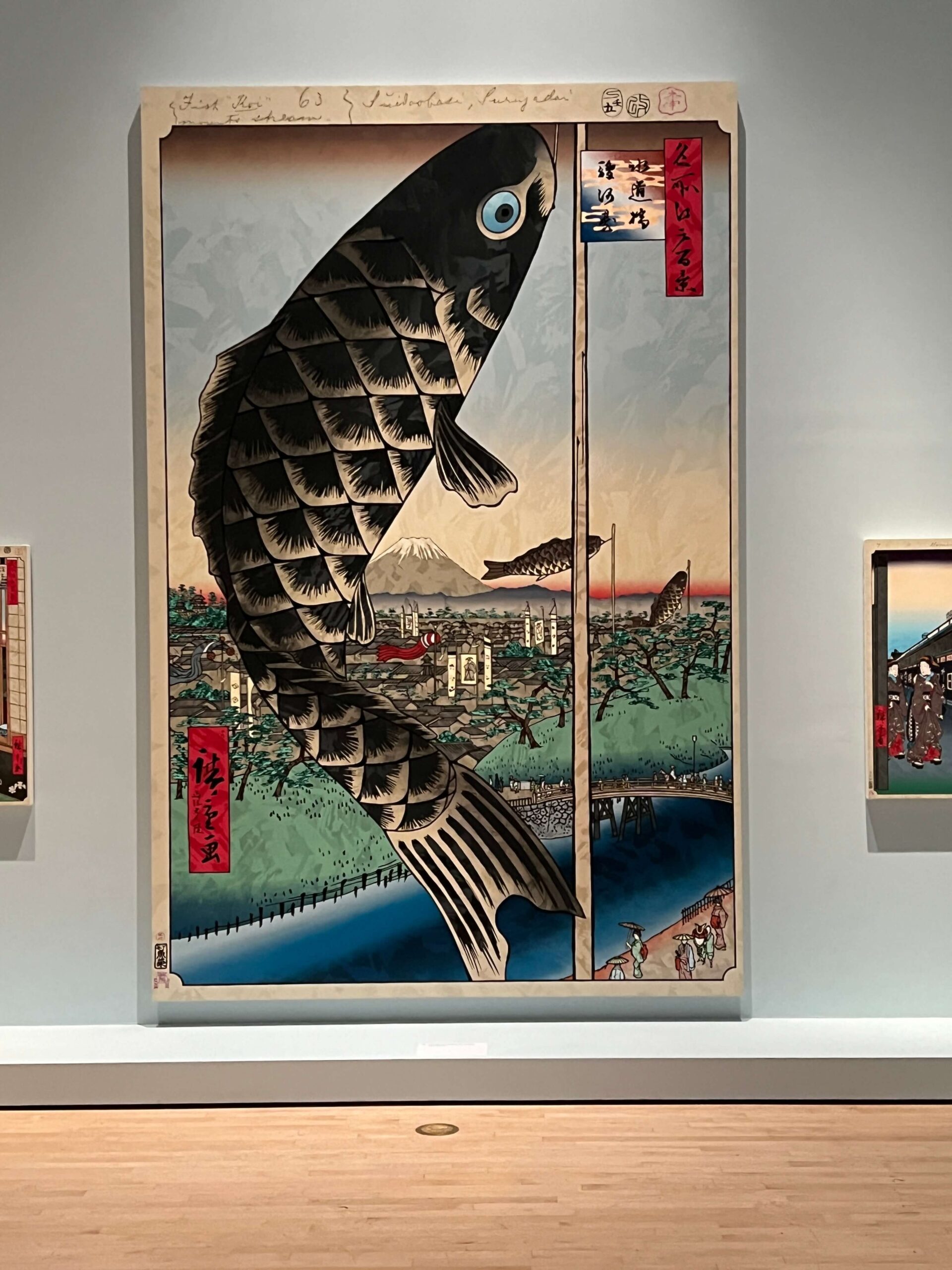The installation of the Brooklyn Museum’s special collection of 100 Views of Edo is on view until August 4. With the cherry blossoms clinging to the branches and the blockbuster “Giants” also on view, the museum offers an especially diverse and powerful experience.
Hiroshige’s serial masterpiece launches into our Spring of 2024 from the Spring of 1856 as we watch the snow melts on the roofs of a crowded commercial seaport. Mt Fuji commands the top of the picture proudly overseeing the bustle of activity. Not apparent but much in the minds of contemporary viewers was that the city had only recently recovered from a devastating earthquake. Local sensors wanted good news and all that we see is rebirth, A wooden bridge in the middle ground is crowded with a tangle of figures, Warehouses and cargo laden boats await their intercourse. A deep blue waterway courses through carrying the life of the city. Everywhere enterprise is thriving, exchange is pervasive. After this busy landfall we proceed to another 99 extraordinary sites of what was the world’s third largest city after London and Beijing. The tour wanders through the seasons and through a magic landscape composed of the favorite haunts and best known landmarks of Edo , modern day Tokyo. The series was created by Utagawao Hiroshige, a fervent lover of his native city and a practitioner of the tradition of the Japanese woodblock print. These gems were originally created between the years 1856 and 1858. Like other issues these were printed for popular markets both domestic and foreign One can find these familiar depictions in every corner of the world. And that these images are now iconic is an understatement. Their compositional perspectives and techniques of cropping and foreshortening were soon adopted by French impressionist painters, notably Van Gogh, Art Nouveau poster designers and European landscape and grand tour photographers. The images collectively form a comprehensive catalog of inspired visual devices to depict humans in the natural and man-made environment. Their influence on the graphic arts is inestimable.

Accompanying the installation of 100 Views of Edo is an outstanding contemporary homage to Hiroshige by the painter Takashi Murakami.
As the Brooklyn Museum begins it’s historic celebratory anniversary it is interesting to note the local legend of this particular portfolio involves the accidental discovery after a dormant 40? years in the once thriving Brooklyn Museum Library. According to the creation myth I was told back in the 70’s a patron (or museum curator) discovered the intact, original but undocumented portfolio in the library stacks while searching for unrelated material. They were originally donated to the Museum in 1916? by a missionary affiliated with a western school in Japan and left forgotten and uncatalogued until 1956?. This anecdote and it’s anniversaries add the charm of buried treasure to a remarkable landmark of Japanese art and a major holding for the Brooklyn Museum. It is among the finest complete sets in the world, albeit from a somewhat later, 1860? edition. Except for some pencil annotations they are in near perfect original condition. As might be expected the lights are kept purposefully low to preserve the vivid but fugitive colors.
Hiroshige used a traditional method of block printing in which individual wooden blocks are carved in relief for each color of the print, and with the assembly of multiple graphic layers and perfect registration the process creates a sense of pictorial depth and fabulous harmonies of color .There is a theme of brilliant blue which marches across the walls in a fluid line that ties the ensemble together as the water and sky tie together the ancient city of Edo, Images of modern Tokyo and the locations of the views and contemporary scenes accompany the exhibit on text panels.Curiosity sent me to online images of modern Tokyo and it’s density and immensity provide a startling contrast to the apparent serenity and order of mid 19th century Japan. . An earlier influence and predecessor, Hokusai, created the iconic image of Mt Fuji rising above the tangle of mountain-like surf in an earlier series from the 1830’s entitled “36 Views of Mt Fuji”, Japanese culture is a treasure to discover. The curators have chosen to include some exquisite domestic objects and costumes some of which are depicted in the prints to add context and continuity. Japan was opening to the world with wholly unexpected consequences.
Discover these treasures for yourself! In print after print the vitality of urban life and it’s nearby suburban counterparts human effect is everywhere, The bonzai curled branch of a cherry tree frames a distant subject, made by people, seen by people, humans unashamedly occupying the natural world, proudly even suggesting their essential roles in the natural world. The consistent theme of brilliant blue of sky and water and costume tie the 100 works together like interconnected blood vessels All heralding a culture of totality, a symbol of human nature.
“Giants” is an exhibition of contemporary African American art of heroic scale and ambition and deserves special attention. Expect to spend the better part of the day. I found myself filled with awe of the worlds of art. I believe we are enjoying the most incredible cornucopia of culture in history and the abundance and access are unprecedented. Take advantage and go see the art.










